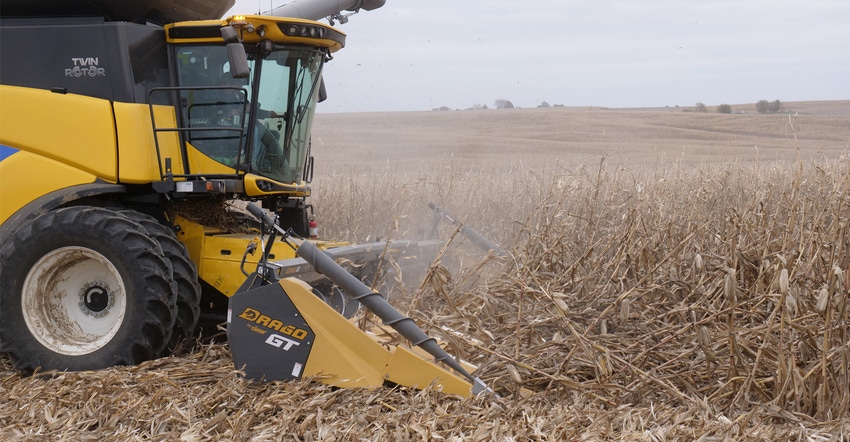
It was around Oct. 20 when combines finally got back in the fields in Iowa. With the wet weather earlier this fall, it hasn’t been an easy harvest. And it isn’t over yet, corn and soybeans are still standing in some fields, waiting to be harvested. How long will they remain standing is the question — probably not long if windy conditions come.
The 2018 Iowa harvest is posing many challenges. Higher-than-average harvest losses are likely due to excessive soybean shatter, flooded and wet field conditions, and lodged corn and beans.
Bushels lost
“Harvest losses can only be managed if you know where and why they are occurring,” says Shawn Shouse, Iowa State University Extension ag engineering field specialist.
Measuring harvest loss requires stopping the combine in the field, backing up 15 to 20 feet, and counting lost beans or kernels in a measured area on the ground. ISU bulletins PM 573, Profitable Soybean Harvesting, and PM 574, Profitable Corn Harvesting, offer guidance on measuring, evaluating and managing harvest losses.
Soybean shatter has been identified as a particular concern this fall. Faster reel speed is often associated with increased shatter loss. Try reducing reel speed if shatter loss is excessive. Unfortunately, reduced reel speed can also make it difficult to gather lodged stems. Both challenges may be present in the same field this year.
Managing lodged soybeans at harvest
A Michigan State University bulletin offers additional advice on harvest settings and management for lodged soybeans:
• Decrease your ground speed to 2.5 to 3 mph.
• Increase the reel speed in relation to the ground speed incrementally to the point that the lodged plants are being cut and gathered into the combine without beating the beans out of the pods.
• Position the cutter bar as close to the ground as possible.
• Angle the pickup fingers on the reel back slightly to more aggressively pull the lodged plants to the cutter bar. Reduce the angle of the fingers if the plants are riding over the top of the reel.
• Run the reel axle 9 to 12 inches ahead of the cutter bar.
• Contact the manufacturer for specific recommendations if using an air-assisted reel.
• Operate the reel as low as necessary to pick up lodged plants without causing them to ride over the top of the reel. Raise the reel if this happens.
• Consider installing vine lifters on the cutter bar if the plants are severely lodged.
• If the plants are badly lodged in one direction, try adding vine lifters to the cutter bar and harvesting at a 30- to 45-degree angle to the direction of the lodging. If this doesn’t work, harvest all the lodged plants in the direction opposite to way they are leaning.
Harvest carefully to reduce loss
Lodged corn also presents serious challenges for controlling harvest loss. Retired ISU ag engineer Mark Hanna offered this advice for reducing harvest loss with lodged corn: "Slowing combine travel speed may reduce the amount of missed ears. Harvesting ‘against the grain’ (against the direction of stalk lean) also may reduce losses. Evaluate attempted improvements by measuring losses again.
“Make sure ear savers on the corn head are in good condition. Keep gathering snouts as low as practical to pick up downed stalks. Gathering chains may need to be more aggressive. Place stripper bars closer together if ear butt-shelling occurs on the stalk rolls.
“If many acres of severely lodged corn are present and the window of time for harvest is short, consider procuring a corn head reel or other attachments such as crop dividers or lifters. Several after-market manufacturers market reels that can be mounted over the corn head to help lift and guide stalks into the head.
“Check availability through dealers or the Internet. Even if a reel doesn’t decrease losses, it may allow faster combine travel speed with similar losses, allowing harvest to proceed in a more-timely manner. Crop dividers mounted on each side of the head help to lift ears into the head that might otherwise escape."
Every harvest brings challenges
“When crop and soil conditions add difficulty, it is important to keep your safety and health in mind,” Shouse says. “While harvest speed matters, take care to not rush your own actions or decisions to the point of increasing the risk of accidents or injury. Your safety and health should always be the first priority.”
About the Author(s)
You May Also Like




